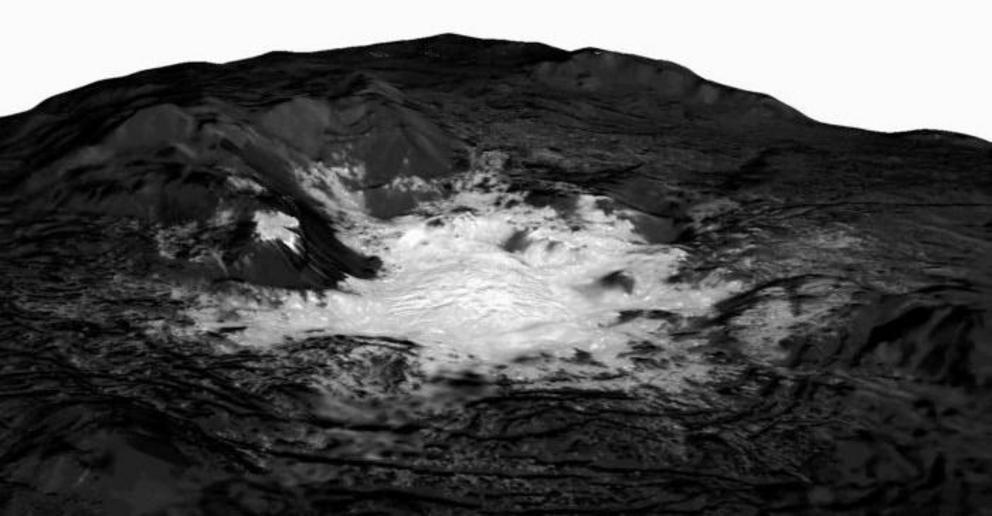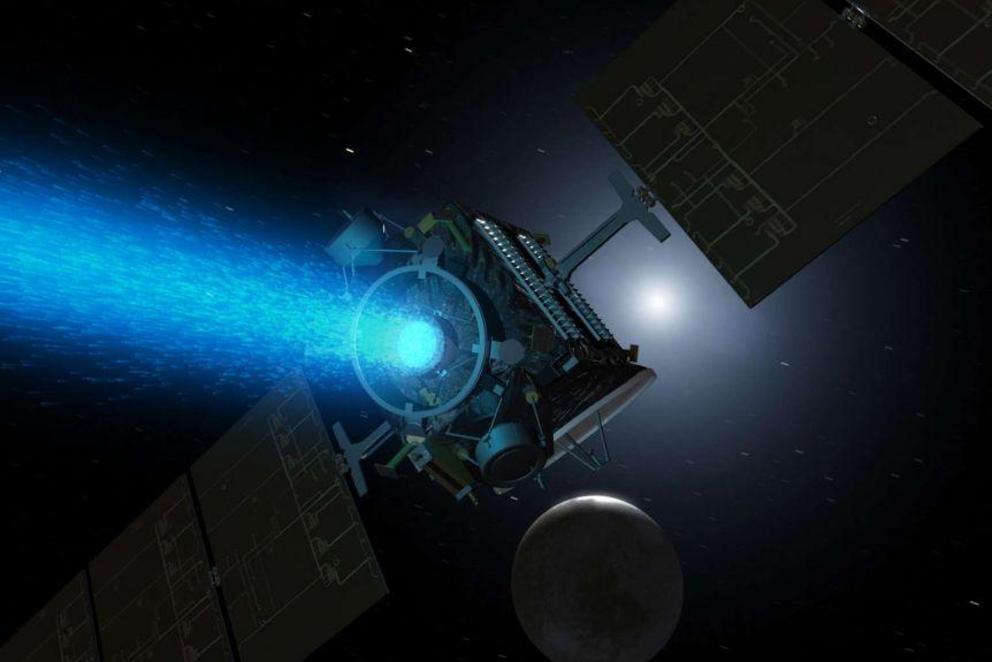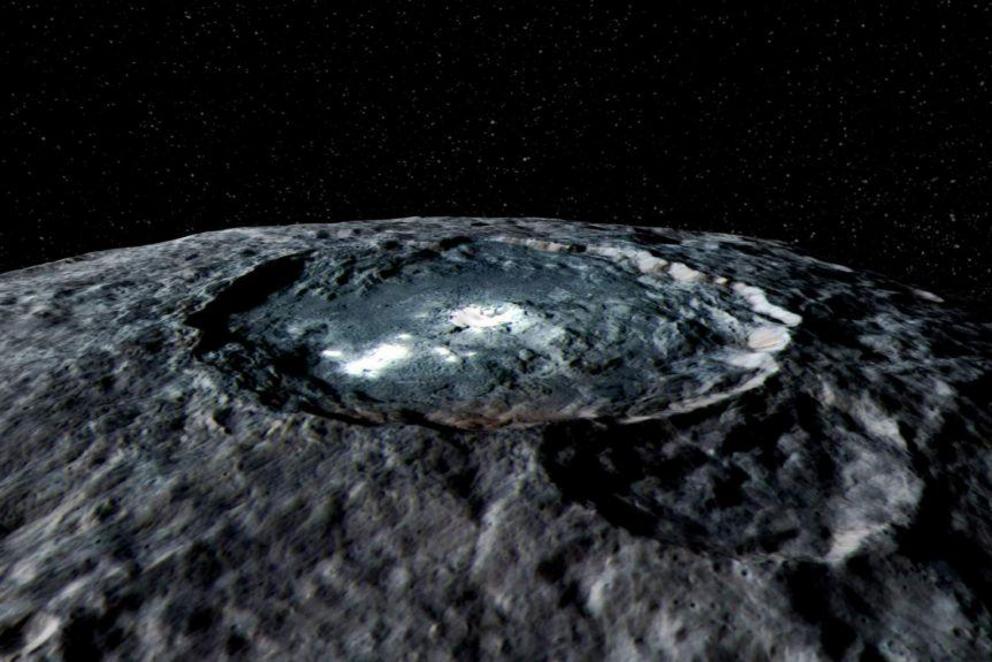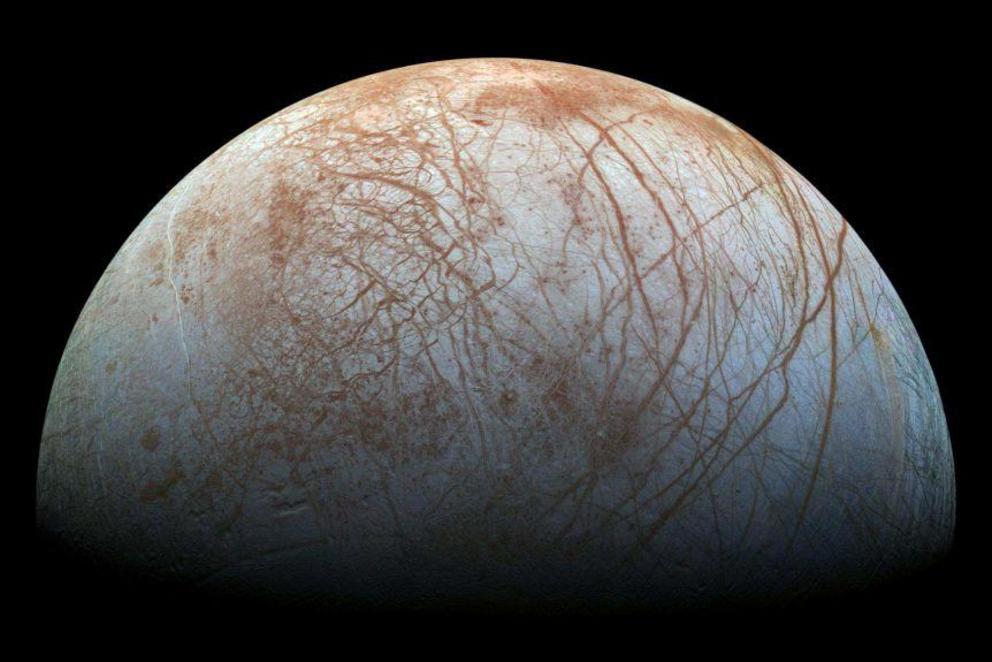Ceres is an ocean world with active geology, according to close-up data from NASA spacecraft Dawn
Imagine you're standing in the middle of a crater nearly 100 kilometres wide and 4km deep.
The world around you is an incredibly dark, cindery-looking place — the colour you'd expect to find inside a black toner cartridge.
Key points:
- Recent salt deposits on the surface of Ceres suggest it's still geologically active and has a sub-surface brine reservoir
- This confirms Ceres is an ocean world
- It may have once been a suitable environment for life — and could be again
You are surrounded by rocks and mounds, with the steep walls of the crater in the distance. But in front of you, in the middle of the crater, is a mountain of bright, shimmering crystals.
It's called Cerealia Tholus, a rounded peak at the centre of the Occator crater. It's the brightest spot on the dwarf planet Ceres — and according to findings published today, it's one of the most interesting places in the solar system.
"It's such an alien landscape," says Carol Raymond, a program scientist for NASA's Jet Propulsion Laboratory at the California Institute of Technology.
"When I talk about it, I just want to be there so badly."
Ceres is the largest object in the asteroid belt between Mars and Jupiter and the only dwarf planet inside the orbit of Neptune.
"To me, it's just so beautiful because it has so much complexity and so much mystery," Dr Raymond says.

Dawn got as close as 35 kilometres to Ceres' surface, enabling it to create image mosaics like this one of Cerealia Facula.(NASA/JPL-Caltech/UCLA/MPS/DLR/IDA/PSI)
And she knows what she's talking about: Dr Raymond is a co-author on each of the seven papers about Ceres, all published in Nature Research journals today.
The papers are packed with data from the last phase of the Dawn mission, when the spacecraft dipped as close as 35km to the dwarf planet's surface, focussing in particular on the 20-million-year-old Occator crater.
This allowed the research team to analyse the planet with more precision than had ever been achieved at an icy body before.

This artist's concept shows NASA's Dawn spacecraft arriving at the dwarf planet Ceres.(NASA: JPL)
"Wow," says Michele Bannister from the University of Canterbury, an astrophysicist and keen observer of the mission. "I keep coming back to how impressive this dataset is.
"Dawn's ability to stay at Ceres and keep mapping this out has been the gift that keeps on giving."
Far from being a primitive relic from the start of the solar system, as we once thought, this new data shows that Ceres certainly hasn't just sat around for the last four and a half billion years.
It's been busy.
Ceres was geologically active recently, and may still be active today
We already knew that Ceres had been home to ice volcanoes or cryovolcanic activity, due in part to the presence of bright sodium carbonate salts on its surface.
Now Dr Raymond is confident that they've identified a deep brine reservoir that still exists beneath the Occator crater.
"Material's still coming up, until the very recent past, from that reservoir — and leaving these fabulous deposits on the surface," she says.
What's more, this activity has persisted much longer than we would expect from just the heat of the impact that carved out the crater.

Scientists are confident there's a deep brine reservoir under Occator crater.(NASA: JPL)
Critically, the research team looked closely enough to discover the chemical make-up of Cerealia Facula, the bright area containing Cerealia Tholus.
They found that it's made not only of sodium carbonate but also contains hydrohalite, or hydrated sodium chloride, right on the top of Cerealia Tholus.
It's the first time we've found hydrohalite anywhere beyond Earth, and Dr Raymond says it's not stable at the surface of Ceres.
"It would dehydrate within — generously — 100 years, but it could be even faster than that," she says.
This means that Ceres could still be active today.
It's an ocean world, but not like some of the others
Another big idea to emerge from this data is that Ceres belongs firmly in the realm of what we call ocean worlds, says planetary scientist Craig O'Neill of Macquarie University, who wasn't involved in the research.
That doesn't mean there's water sloshing around on the surface of Ceres — but it does appear to have liquid reservoirs beneath the surface.
Moons like Europa and Enceladus, orbiting Jupiter and Saturn respectively, are also ocean worlds, where the tidal energy generated by their orbits around the gas giants melts their interiors, Dr O'Neill says.
"You end up with an ocean in there, which life could potentially live in."

Unlike Ceres, the icy moon Europa gets tidal energy from orbiting Jupiter.(NASA/JPL-Caltech/SETI Institute)
Ceres is in a completely different situation, out in the asteroid belt and millions of miles from anywhere, he says. It's not getting any energy at all except from a bit of radioactivity in its interior, although not enough to keep it hot for long periods of time like Earth.
How it became an ocean world is still a million-dollar question, Dr O'Neill says, but it looks like the interior of Ceres does contain liquid: really, really salty liquid, or brine.
One of the reasons all the liquid inside Ceres hasn't frozen could be the chemistry of its crust, which contains compounds called clathrates.
Clathrates are gas molecules trapped inside water "cages" and do a great job of insulation.
"The cool thing about clathrates is they conduct heat really poorly; they're like having an esky around your planet," Dr O'Neill says.
In this way, they could slow the heat loss from Ceres.
What does all this mean for life on Ceres?
From what we understand about Ceres' history, Dr Raymond thinks there would have been some part of its evolution when it was habitable.
It was warmer, the ocean was thicker and there was plenty of energy around due to all the chemical alterations happening on the planet.
"But it's unlikely that that persisted over sufficient time to allow the emergence of life," she says.
So if life ever did exist, it would have taken an interplanetary hitchhiker, like a type of extremophile bacteria, to make the most of the conditions.
But if another object had a big enough impact with Ceres to mobilise the water and the salts on the planet and create an impact melt chamber, these habitable conditions could emerge again.
"We think [if that happened], this could be an analogue for any icy moon," Dr Raymond says.
Want even more science, health and tech? Join the conversation on Facebook.
Dr O'Neill, meanwhile, is more optimistic about Ceres' current habitability.
"I am sure that someone's found a lifeform, a little archaea bug living in a deep ocean vent or something, that could live under these conditions," he says.
"It's almost certain that something out there could handle the conditions in the interior of Ceres, which means when we're thinking of things like habitability.
"We have to expand the scope of potential environments in the solar system that are habitable, all over again."
Dr Bannister says we have to figure out more about what's going on in Ceres.
"If you have salty liquid moving around in the upper layers of this object in the present day — that is something we do not yet have proof of … in the Martian surface," she says.
"It could be that this is the closest-to-Earth environment of that sort in the solar system."
And if Ceres is still active?
"Send a lander tomorrow," Dr Bannister says.
